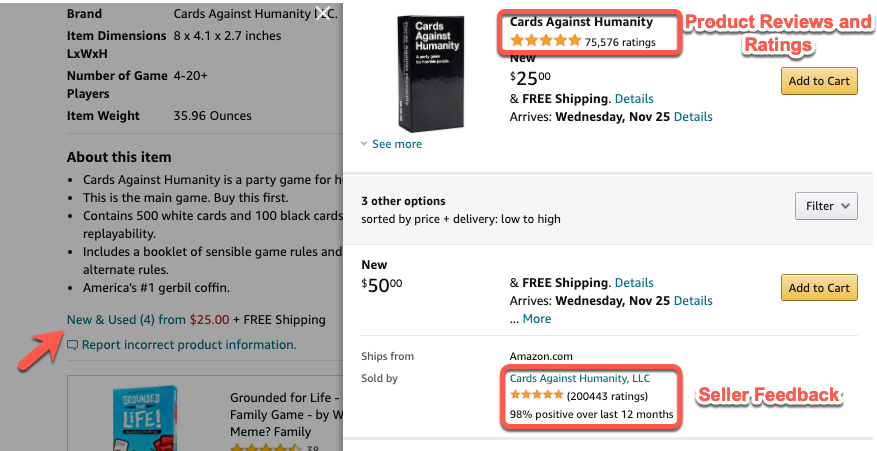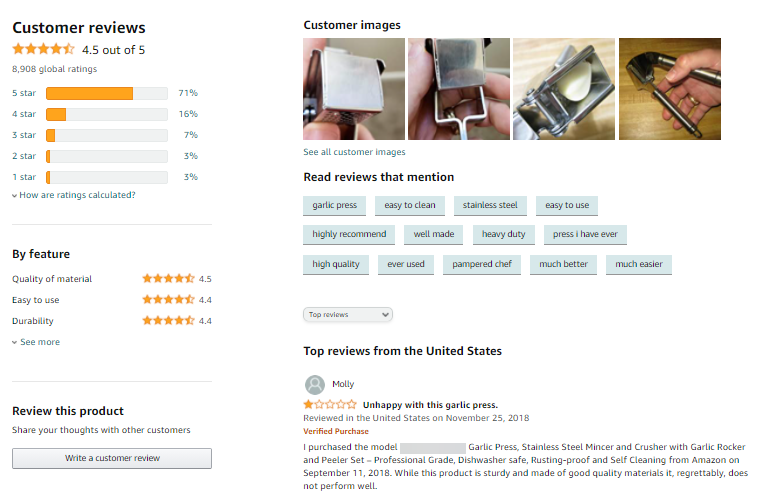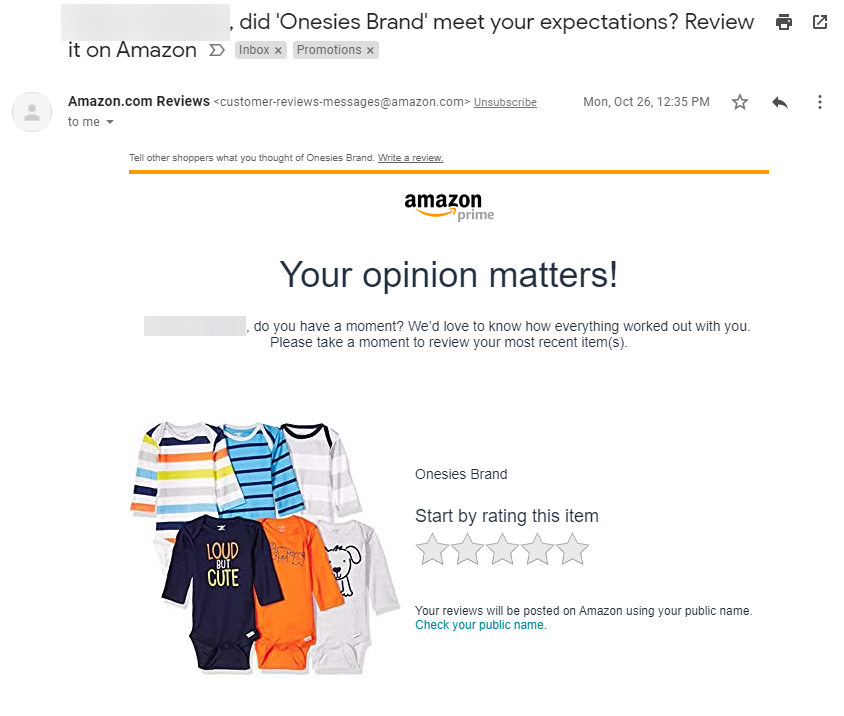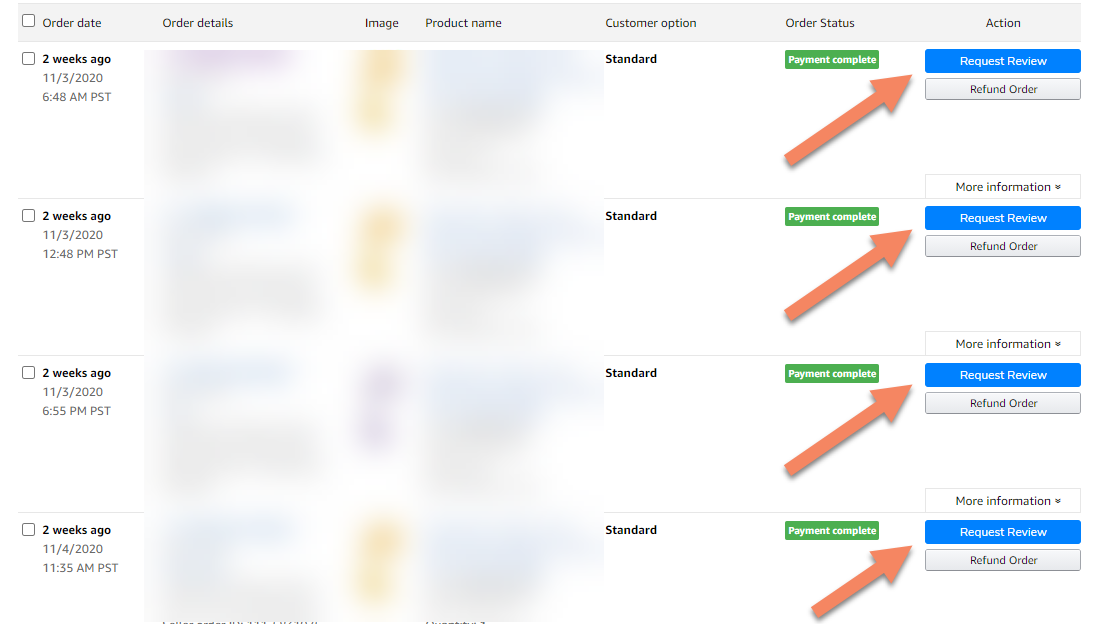SEO
Amazon Product Review Best Practices

Reviews are a fundamental part of buying on Amazon. They have also been one of the areas that have changed the most over the last decade.
As Amazon continues to mature as a marketplace, it has become very sensitive to review manipulation. Using outdated tactics can trigger Amazon to remove most, if not all, of your listings.
Even worse, if you are identified as someone manipulating reviews on Amazon, you could be permanently banned from the platform.
Amazon is stringent about reviews because, in the not-too-distant past, reviews were the primary way to manipulate the Amazon search algorithm to have your product show up at the top of search.
While reviews are still important for marketing your products on Amazon, the best practices around reviews have changed significantly in the last few years.
Many of even the legitimate ways used by sellers to gather reviews have disappeared or can now potentially get your listing flagged.
In this article, we will discuss some of the most critical information when creating a product reviews strategy on Amazon in today’s climate.
Over the last several years, Amazon determined that many practices around soliciting reviews were diminishing the reputation of reviews on its platform.
As a result, significant changes around actively monitoring review manipulation are put in place. It includes changing the regulations around how Amazon can reach out to customers to get reviews and what kind of incentives can be offered.
Amazon has tried to balance giving sellers legitimate ways to get their products reviewed while limiting the amount of fraud around reviews.
Having customers trust Amazon reviews is a top priority to protect how reviews are regarded on the platform.
Fundamentals Of Amazon Product Reviews
The importance of reviews derives from the credibility they provide to your product. They help the customer determine if your product is a good fit and can be trusted to be sufficient in quality.
Reviews, in turn, help your listing conversion and even your ad conversion.
Often, the question most sellers struggle with is this: How many reviews do I need for my product to succeed on Amazon?
The answer to that will largely depend on how commoditized or competitive your product category is.
The more competitive your category, the more reviews your product will need to compete against similar products.
For example, if you launch a mobile phone case, you will compete with other items with 10,000 or more reviews. This shows that to have your reviews provide real credibility to your product, you will need a larger number of reviews.
On the other hand, if your product is very niche, you may only need 5 to 15 reviews to be retail-ready. Amazon recommends at least 15 reviews for a listing before you start scaling advertising.
However, for niche products, Amazon has successfully ramped up advertising with strong performance well before that total number of reviews.
Finally, brand awareness will also impact the role of reviews for your product. For example, an official Lego product will sell well despite no reviews.
This is because there is a much-existing affinity for the brand. That same product will sell better, and ads will convert at a higher return on investment (ROI) once it has established reviews.
However, the product doesn’t need reviews to make the customers feel confident in their purchase.
Reviews should be an important part of your listing optimization strategy. This does not only apply to converting traffic that comes to your listing but also to increasing the amount of traffic that comes from the search engine result page (SERP).
Keep in mind that your product rating score will show up in the SERP as well as in your ads. Additionally, customers can filter their results by average reviews.
While it is common for brands to be concerned with any negative review, know that an occasional negative review can help show buyers that your reviews are authentic. No product has a 100% adoption rate.
You should be proactively working to reduce the number of negative reviews on your products. Do this by ensuring your product detail page is as clear as possible.
You should also be reviewing Voice of the Customer in Seller Central on a weekly basis to identify any potential negative customer experiences before Amazon might suppress your listings.
Voice of the Customer is an important tool to be able to anticipate issues with quality control or even the content of your listing.
You should look at all negative customer experiences (NCX) to see what you can do proactively to avoid future returns and negative reviews.
Voice of the Customer can be found in Seller Central under the Performance tab.
 Screenshot from Amazon, March 2023
Screenshot from Amazon, March 2023Use Voice of the Customer as part of your Amazon review strategy to help you limit negative reviews on your products. This can also help you avoid Amazon Standard Identification Number (ASIN) restrictions and reduce your overall return rates.
Feedback Vs. Reviews & Ratings
One common point of confusion for new sellers is the difference between feedback and reviews.
“Seller Feedback” refers to the customer’s experience with the seller, not the product itself.
Seller Feedback
Sellers are rated on different factors, such as shipment times, packaging, product accuracy, and significant customer service experiences.
Seller feedback is found on the Seller Central dashboard, the seller store page, and the product detail page by clicking the offers link.
 Screenshot from Amazon, March 2023
Screenshot from Amazon, March 2023Product Reviews
Product reviews specifically rate whether the product meets the customer’s expectations.
Product reviews are located at the bottom of the detail page, while the total of both reviews and product ratings are displayed at the top of the listing, below the brand name.
It is important to note that it is against Amazon’s terms of service to have family, friends, or employees review your product or a competitor’s product.
Reviews that violate community standards can be flagged for removal. Amazon will only remove reviews that violate the specific conditions outlined in the community guidelines.
 Screenshot from Amazon, March 2023
Screenshot from Amazon, March 2023Recently, Amazon started allowing customers to provide ratings without giving a review.
It has the same star rating as reviews (one to five) and counts toward your overall customer review totals, but it has no accompanying text. This is why some products might have thousands of stars but only a handful of written reviews.
Programs To Help You Get Legitimate Reviews
Amazon has implemented some tools to help sellers get reviews, especially newcomers to the platform that need those coveted first reviews.
Amazon Vine
Amazon Vine is a program exclusive to those brands enrolled in the Brand Registry Program.
Here is what Amazon says about the Vine program:
“Amazon Vine invites the most trusted reviewers on Amazon to post opinions about new and pre-release items to help their fellow customers make informed purchase decisions. Amazon invites customers to become Vine Voices based on their reviewer rank, which is a reflection of the quality and helpfulness of their reviews as judged by other Amazon customers.
Amazon provides Vine members with free products that have been submitted to the program by participating vendors. Vine reviews are the independent opinions of the Vine Voices. The vendor cannot influence, modify, or edit the reviews. Amazon does not modify or edit Vine reviews, as long as they comply with our posting guidelines. A Vine review is identified with the green stripe Customer review from the Amazon Vine Program.”
Amazon handpicks Vine reviewers due to their expertise and history in reviewing a certain product category, so expect highly detailed and honest reviews.
In this Amazon-coordinated program, you send customers your product, and they give you a review in return.
Before enrolling in the Vine program, you must be confident your product will surprise and delight your customers.
Amazon usually waits until a newly launched product has at least five positive reviews before enrolling in the Amazon Vine Program. This allows the platform to ensure no breakage, quality, or content issues must be addressed.
Amazon Vine reviewers are notoriously detailed and honest.
Negative reviews from a Vine user can be especially detrimental because of the length and detail. However, a glowing review can go a long way in helping to build trust and increase conversion for your products.
The cost for utilizing this program is $200 per parent ASIN. There are also specific requirements for the program, including:
- Be brand registered in Amazon Brand Registry.
- Have fewer than 30 reviews on the product detail page.
- Have a buyable Fulfillment by Amazon (FBA) offer in “New” condition.
- Not be an adult product.
- Have already launched at the time of enrolment.
- Have available inventory.
- Have an image and a description.
Introduction To “Request A Review” Button & Ratings
In 2020, Amazon released a new tool for sellers: A button for each order a customer places within the last 5 to 30 days.
Sellers can now simply click the Request a Review button, and an email is auto-generated and sent to the customer.
As a seller, you click on the button then the buyer will receive an email soliciting a star rating for both the product and the seller.
The email is not customizable, and it is sent to customers by Amazon itself, which helps to avoid the complications of making sure that your wording complies with the terms of service, while still being able to request reviews on all your orders.
 Screenshot by author, March 2023
Screenshot by author, March 2023Using the Request a Review button can be done with the following steps.
To send your customer a request for a seller and product rating, go to Seller Central > Orders > Manage Orders.

If you are primarily FBA, make sure it says “View Seller Fulfilled Orders.” If it says View FBA orders, click that link.
This allows you to toggle between the fulfillment methods.
Then, find the order you want to request a review for and click on where the order number is displayed.
 Screenshot from Amazon, March 2023
Screenshot from Amazon, March 2023Then click the Request a Review button.
 Screenshot from Amazon, March 2023
Screenshot from Amazon, March 2023Several tools on the market now allow to automate this process. It is always important to ensure that the third-party software you use follows Amazon’s terms of service.
Reviews are still vital on Amazon to help you increase conversion rates and lower advertising costs. However, they are no longer the quick-and-easy hack to get the top of the organic results they once were.
 Screenshot from Amazon, March 2023
Screenshot from Amazon, March 2023As more sellers use this tool, Amazon sees an increase in the number of product ratings without accompanying text.
Soliciting Reviews
Here is what Amazon says about soliciting reviews:
“Solicitations:
If you ask others to post content about your products, keep it neutral. For example, don’t try to influence them into leaving a positive rating or review.
Don’t offer, request, or accept compensation for creating, editing, or posting content. Compensations include free and discounted products, refunds, and reimbursements.
Don’t try to manipulate the Amazon Verified Purchase badge by offering reviewers special pricing or reimbursements.
Have a financial or close personal connection to a brand, seller, author, or artist?
- It’s OK to post content other than reviews and questions and answers, but you need to clearly disclose your connection. However, brands or businesses can’t participate in the community in ways that divert Amazon customers to non-Amazon websites, applications, services, or channels. This includes ads, special offers, and “calls to action” used to conduct marketing or sales transactions. If you post content about your own products or services through a brand, seller, author, or artist account, additional labeling isn’t necessary.
- Authors and publishers can continue to give readers free or discounted copies of their books if they don’t require a review in exchange or try to influence the review.”
It is important to actively reach out to customers to get reviews, but also know that it is better to wait for the reviews to accrue over time rather than trying to cheat the system and have your other reviews removed or, worse, potentially have an account suspension.
This also helps to ensure that customers can feel confident in the authenticity of reviews on Amazon.
While many review services on the market promise to cheat the system to get more reviews, remember that Amazon is aggressively pursuing these companies by closing loopholes and even by using litigation to stop these tactics.
If Amazon catches you using black hat tricks for reviews, it can be very difficult to be reinstated, and you could lose access to the platform as a whole.
Conclusion
For our clients, we find that we can gather enough reviews to obtain customer confidence with the available programs. This includes utilizing Voice of the Customer to avoid negative reviews and strategically organizing variation listings on Amazon to have healthy conversion rates.
As the marketplace grows, Amazon is closing the quick and easy ways to rank; sellers need to learn to develop more strategic launches with products that customers genuinely love.
This has also allowed Amazon to rebuild some of the trust customers have in the reviews on the platform.
Because Amazon is a dynamic and ever-changing ecosystem, it’s essential to regularly check for updates and changes to the terms of service and marketplace guidelines.
Everything in this article is based on the specific state of Amazon Policies at the time it was written.
However, policies can change quickly, so double-check the policies to ensure that what is being recommended here is still the current policy.
More Resources:
Featured Image: Black Salmon/Shutterstock
SEO
Measuring Content Impact Across The Customer Journey

Understanding the impact of your content at every touchpoint of the customer journey is essential – but that’s easier said than done. From attracting potential leads to nurturing them into loyal customers, there are many touchpoints to look into.
So how do you identify and take advantage of these opportunities for growth?
Watch this on-demand webinar and learn a comprehensive approach for measuring the value of your content initiatives, so you can optimize resource allocation for maximum impact.
You’ll learn:
- Fresh methods for measuring your content’s impact.
- Fascinating insights using first-touch attribution, and how it differs from the usual last-touch perspective.
- Ways to persuade decision-makers to invest in more content by showcasing its value convincingly.
With Bill Franklin and Oliver Tani of DAC Group, we unravel the nuances of attribution modeling, emphasizing the significance of layering first-touch and last-touch attribution within your measurement strategy.
Check out these insights to help you craft compelling content tailored to each stage, using an approach rooted in first-hand experience to ensure your content resonates.
Whether you’re a seasoned marketer or new to content measurement, this webinar promises valuable insights and actionable tactics to elevate your SEO game and optimize your content initiatives for success.
View the slides below or check out the full webinar for all the details.
SEO
How to Find and Use Competitor Keywords

Competitor keywords are the keywords your rivals rank for in Google’s search results. They may rank organically or pay for Google Ads to rank in the paid results.
Knowing your competitors’ keywords is the easiest form of keyword research. If your competitors rank for or target particular keywords, it might be worth it for you to target them, too.
There is no way to see your competitors’ keywords without a tool like Ahrefs, which has a database of keywords and the sites that rank for them. As far as we know, Ahrefs has the biggest database of these keywords.
How to find all the keywords your competitor ranks for
- Go to Ahrefs’ Site Explorer
- Enter your competitor’s domain
- Go to the Organic keywords report
The report is sorted by traffic to show you the keywords sending your competitor the most visits. For example, Mailchimp gets most of its organic traffic from the keyword “mailchimp.”


Since you’re unlikely to rank for your competitor’s brand, you might want to exclude branded keywords from the report. You can do this by adding a Keyword > Doesn’t contain filter. In this example, we’ll filter out keywords containing “mailchimp” or any potential misspellings:


If you’re a new brand competing with one that’s established, you might also want to look for popular low-difficulty keywords. You can do this by setting the Volume filter to a minimum of 500 and the KD filter to a maximum of 10.


How to find keywords your competitor ranks for, but you don’t
- Go to Competitive Analysis
- Enter your domain in the This target doesn’t rank for section
- Enter your competitor’s domain in the But these competitors do section


Hit “Show keyword opportunities,” and you’ll see all the keywords your competitor ranks for, but you don’t.


You can also add a Volume and KD filter to find popular, low-difficulty keywords in this report.


How to find keywords multiple competitors rank for, but you don’t
- Go to Competitive Analysis
- Enter your domain in the This target doesn’t rank for section
- Enter the domains of multiple competitors in the But these competitors do section


You’ll see all the keywords that at least one of these competitors ranks for, but you don’t.


You can also narrow the list down to keywords that all competitors rank for. Click on the Competitors’ positions filter and choose All 3 competitors:


- Go to Ahrefs’ Site Explorer
- Enter your competitor’s domain
- Go to the Paid keywords report


This report shows you the keywords your competitors are targeting via Google Ads.
Since your competitor is paying for traffic from these keywords, it may indicate that they’re profitable for them—and could be for you, too.
You know what keywords your competitors are ranking for or bidding on. But what do you do with them? There are basically three options.
1. Create pages to target these keywords
You can only rank for keywords if you have content about them. So, the most straightforward thing you can do for competitors’ keywords you want to rank for is to create pages to target them.
However, before you do this, it’s worth clustering your competitor’s keywords by Parent Topic. This will group keywords that mean the same or similar things so you can target them all with one page.
Here’s how to do that:
- Export your competitor’s keywords, either from the Organic Keywords or Content Gap report
- Paste them into Keywords Explorer
- Click the “Clusters by Parent Topic” tab


For example, MailChimp ranks for keywords like “what is digital marketing” and “digital marketing definition.” These and many others get clustered under the Parent Topic of “digital marketing” because people searching for them are all looking for the same thing: a definition of digital marketing. You only need to create one page to potentially rank for all these keywords.


2. Optimize existing content by filling subtopics
You don’t always need to create new content to rank for competitors’ keywords. Sometimes, you can optimize the content you already have to rank for them.
How do you know which keywords you can do this for? Try this:
- Export your competitor’s keywords
- Paste them into Keywords Explorer
- Click the “Clusters by Parent Topic” tab
- Look for Parent Topics you already have content about
For example, if we analyze our competitor, we can see that seven keywords they rank for fall under the Parent Topic of “press release template.”


If we search our site, we see that we already have a page about this topic.


If we click the caret and check the keywords in the cluster, we see keywords like “press release example” and “press release format.”


To rank for the keywords in the cluster, we can probably optimize the page we already have by adding sections about the subtopics of “press release examples” and “press release format.”
3. Target these keywords with Google Ads
Paid keywords are the simplest—look through the report and see if there are any relevant keywords you might want to target, too.
For example, Mailchimp is bidding for the keyword “how to create a newsletter.”


If you’re ConvertKit, you may also want to target this keyword since it’s relevant.
If you decide to target the same keyword via Google Ads, you can hover over the magnifying glass to see the ads your competitor is using.


You can also see the landing page your competitor directs ad traffic to under the URL column.


Learn more
Check out more tutorials on how to do competitor keyword analysis:
SEO
Google Confirms Links Are Not That Important

Google’s Gary Illyes confirmed at a recent search marketing conference that Google needs very few links, adding to the growing body of evidence that publishers need to focus on other factors. Gary tweeted confirmation that he indeed say those words.
Background Of Links For Ranking
Links were discovered in the late 1990’s to be a good signal for search engines to use for validating how authoritative a website is and then Google discovered soon after that anchor text could be used to provide semantic signals about what a webpage was about.
One of the most important research papers was Authoritative Sources in a Hyperlinked Environment by Jon M. Kleinberg, published around 1998 (link to research paper at the end of the article). The main discovery of this research paper is that there is too many web pages and there was no objective way to filter search results for quality in order to rank web pages for a subjective idea of relevance.
The author of the research paper discovered that links could be used as an objective filter for authoritativeness.
Kleinberg wrote:
“To provide effective search methods under these conditions, one needs a way to filter, from among a huge collection of relevant pages, a small set of the most “authoritative” or ‘definitive’ ones.”
This is the most influential research paper on links because it kick-started more research on ways to use links beyond as an authority metric but as a subjective metric for relevance.
Objective is something factual. Subjective is something that’s closer to an opinion. The founders of Google discovered how to use the subjective opinions of the Internet as a relevance metric for what to rank in the search results.
What Larry Page and Sergey Brin discovered and shared in their research paper (The Anatomy of a Large-Scale Hypertextual Web Search Engine – link at end of this article) was that it was possible to harness the power of anchor text to determine the subjective opinion of relevance from actual humans. It was essentially crowdsourcing the opinions of millions of website expressed through the link structure between each webpage.
What Did Gary Illyes Say About Links In 2024?
At a recent search conference in Bulgaria, Google’s Gary Illyes made a comment about how Google doesn’t really need that many links and how Google has made links less important.
Patrick Stox tweeted about what he heard at the search conference:
” ‘We need very few links to rank pages… Over the years we’ve made links less important.’ @methode #serpconf2024″
Google’s Gary Illyes tweeted a confirmation of that statement:
“I shouldn’t have said that… I definitely shouldn’t have said that”
Why Links Matter Less
The initial state of anchor text when Google first used links for ranking purposes was absolutely non-spammy, which is why it was so useful. Hyperlinks were primarily used as a way to send traffic from one website to another website.
But by 2004 or 2005 Google was using statistical analysis to detect manipulated links, then around 2004 “powered-by” links in website footers stopped passing anchor text value, and by 2006 links close to the words “advertising” stopped passing link value, links from directories stopped passing ranking value and by 2012 Google deployed a massive link algorithm called Penguin that destroyed the rankings of likely millions of websites, many of which were using guest posting.
The link signal eventually became so bad that Google decided in 2019 to selectively use nofollow links for ranking purposes. Google’s Gary Illyes confirmed that the change to nofollow was made because of the link signal.
Google Explicitly Confirms That Links Matter Less
In 2023 Google’s Gary Illyes shared at a PubCon Austin that links were not even in the top 3 of ranking factors. Then in March 2024, coinciding with the March 2024 Core Algorithm Update, Google updated their spam policies documentation to downplay the importance of links for ranking purposes.
The documentation previously said:
“Google uses links as an important factor in determining the relevancy of web pages.”
The update to the documentation that mentioned links was updated to remove the word important.
Links are not just listed as just another factor:
“Google uses links as a factor in determining the relevancy of web pages.”
At the beginning of April Google’s John Mueller advised that there are more useful SEO activities to engage on than links.
Mueller explained:
“There are more important things for websites nowadays, and over-focusing on links will often result in you wasting your time doing things that don’t make your website better overall”
Finally, Gary Illyes explicitly said that Google needs very few links to rank webpages and confirmed it.
I shouldn’t have said that… I definitely shouldn’t have said that
— Gary 鯨理/경리 Illyes (so official, trust me) (@methode) April 19, 2024
Why Google Doesn’t Need Links
The reason why Google doesn’t need many links is likely because of the extent of AI and natural language undertanding that Google uses in their algorithms. Google must be highly confident in its algorithm to be able to explicitly say that they don’t need it.
Way back when Google implemented the nofollow into the algorithm there were many link builders who sold comment spam links who continued to lie that comment spam still worked. As someone who started link building at the very beginning of modern SEO (I was the moderator of the link building forum at the #1 SEO forum of that time), I can say with confidence that links have stopped playing much of a role in rankings beginning several years ago, which is why I stopped about five or six years ago.
Read the research papers
Authoritative Sources in a Hyperlinked Environment – Jon M. Kleinberg (PDF)
The Anatomy of a Large-Scale Hypertextual Web Search Engine
Featured Image by Shutterstock/RYO Alexandre
-

 PPC5 days ago
PPC5 days ago19 Best SEO Tools in 2024 (For Every Use Case)
-

 MARKETING7 days ago
MARKETING7 days agoStreamlining Processes for Increased Efficiency and Results
-
SEARCHENGINES6 days ago
Daily Search Forum Recap: April 17, 2024
-

 PPC7 days ago
PPC7 days ago97 Marvelous May Content Ideas for Blog Posts, Videos, & More
-

 SEO6 days ago
SEO6 days agoAn In-Depth Guide And Best Practices For Mobile SEO
-

 MARKETING6 days ago
MARKETING6 days agoEcommerce evolution: Blurring the lines between B2B and B2C
-
SEARCHENGINES5 days ago
Daily Search Forum Recap: April 18, 2024
-
SEARCHENGINES4 days ago
Daily Search Forum Recap: April 19, 2024















